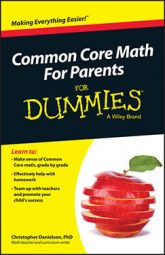States, districts, schools, and teachers have invested a lot of time, money, and effort implementing the Common Core Math Standards — to say nothing of parents. Before the Common Core, each state wrote its own standards for math. Now, nearly all states have agreed on the mathematics students will study in school. Here’s what you need to know about the benefits of seeing through the process of adopting the Common Core Standards.
Most of these benefits come from having a common set of standards — not common in the sense of ordinary, but in the sense of shared.
Equitable access to mathematics: A topic you don’t study is one you don’t have an opportunity to learn. Not all students in US schools have similar opportunities to learn math. In many low-income schools — especially those in big cities, and those with large percentages of students of color — students are more likely to get stuck in endless cycles of review. Such students may not have an opportunity to learn any algebra, for example, because their curriculum constantly reviews fraction arithmetic. With common standards, schools agree to offer opportunities to learn everything at each grade level.
Students who need to review fraction arithmetic will do so while they begin to study algebra, not instead of it. Robert Moses considered mathematics as a tool of liberation. Common standards insist that all schools offer this tool to all students.
Consistent content for mobile students: The United States is a mobile society. Students frequently move between districts and even between states in the midst of the school year. This problem is especially noticeable in urban districts and in school districts that include large populations of agricultural or military workers. A common set of standards makes it much more likely that students who change classrooms midyear will be able to pick up where they left off.
Higher quality standards: In many states, standards are written into law. Yet most legislators have no experience or knowledge of education. You can only imagine how this process can go wrong when 50 states write their own standards. The Common Core Standards take this process out of legislators’ hands. To be sure, states still control whether the Common Core Standards are the law of the land, but after a state has adopted these standards, the details of which math children study at which grade aren’t subject to the whims of the party in power.
Improved textbook development: The Common Core Standards represent a rare opportunity to markedly improve the state of American textbook publishing. Most children in the United States study most of their school math from one or more textbook series published by a major publisher. These publishers have an incentive to create textbooks that can be widely adopted in many states. When states disagree about the grade level for the placement of a topic, publishers tend to include that topic at all grade levels, leading to incoherent and inefficient textbooks. Common standards across the majority of states should allow for more coherent textbook development.
More meaningful professional development: Without common standards, teachers from different locales have difficulty discussing their work. Whether teachers connect at a conference, a training session, online, or at the coffee shop, common standards allow sixth grade teachers to talk to each other about the math they teach. Common standards facilitate sharing problems and solutions for student learning across district and state lines.
Many high-achieving countries have systems in place for consistent and incremental improvement of education. The United States has no such system — at least in part because there is no common baseline on which to build. The result is that teachers see reform after reform sweep through the schools — out with the old and in with the new. Common standards are a necessary starting place for the kind of incremental improvement that supports teacher growth and development in the long term.
Better prepared teachers: The mathematical preparation of teachers before Common Core relied on the whims of state legislatures. “What currently is the content of first grade math?” and “In what state will most of our graduates seek jobs?” were questions on the minds of teacher education faculty members before Common Core. As with K–12 textbooks, when answers to these questions vary, the content of the college textbooks students use needs to vary as well. Creating common agreements about what math teachers need to know will be much easier in an environment where nearly all states have agreed on what math students need to know and when they need to know it.
Better testing: The federal No Child Left Behind Act (NCLB) of 2001 mandates year-by-year testing in grades 3–8. With or without the Common Core Standards, this high stakes testing is the current reality unless Congress alters or repeals NCLB. Before the Common Core Standards, each of the states developed their own tests, usually by contracting with a large publisher. The Common Core Standards present an opportunity to develop a smaller number of better tests. As with all opportunities, whether it’s successful remains to be seen.
Better tracking of national trends: The National Assessment of Educational Progress (NAEP) is given periodically to fourth, eighth, and twelfth graders, and is often referred to with the nickname “The Nation’s Report Card.” NAEP is the main source of information available about national trends in student achievement. The development of the Common Core Standards and associated assessments means that there should soon be data about national trends in student achievement available that goes far beyond NAEP. For example, NAEP isn’t standards-aligned, so it’s not possible to use NAEP data to answer questions about the appropriateness of particular state standards.

